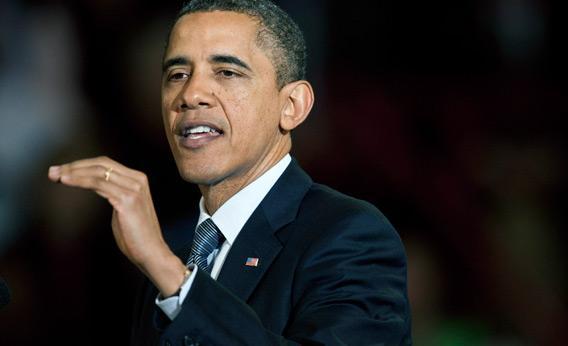President Obama’s top campaign advisers held a briefing for national reporters today in Washington, D.C., an early attempt to persuade the media that victory is possible, or even likely. The inevitable PowerPoint presentation gave the impression of a gathering army and plenty of options. Slides showed that there had been 1 million conversations with voters, 90,000 meetings, and that 45 percent of donors were new ones who had not given in 2008. A screen full of maps showed the five different ways Obama could win the election*, either through a “Western path” where he won states such as Colorado, Nevada, and New Mexico, or a “Florida path.”
The collective message was that the Obama team has built something big enough to withstand the deluge of bad data and historical trends that are working against the president: the high unemployment rate, an average approval rating that is seven points below the key benchmark of 50 percent, and a vast majority of voters who think the country is going in the wrong direction.
A USA Today/Gallup analysis of swing states that came out this morning showed Republicans are more enthusiastic than Democrats. The president’s swing-state poll numbers are worse than they are among the general public. Both Romney and Gingrich lead Obama in those states.
President Obama’s strategists, of course, had their own numbers showing that Obama was doing better in those states. They quibbled with the USA Today/Gallup findings, prompting one reporter to joke that Susan Page of USA Today, who sat typing on her laptop, should get 30 seconds to respond.
The second task of the presentation was to convince us that the Republican nominating fight has become extremely ugly. There has been a lot of talk about which GOP candidate the White House would rather run against. In this briefing, Obama’s aides took shots at both Gingrich and Romney, though David Axelrod’s characterization of the former speaker was the most colorful. “Just remember the higher a monkey climbs on a pole,” Axelrod said, quoting an expression a Chicago Alderman taught him, “the more you can see his butt. So, you know, the speaker is very high on the pole right now and we’ll see how people like the view.”
Ultimately the Republican nominee doesn’t matter, said the president’s men, because the GOP nomination is an ever more extreme contest controlled by the far reaches of the Tea Party. “They’re mortgaging themselves for the general by tacking as far as they are,” said Axelrod, pointing to hard-line stances against illegal immigrants that will hurt with Hispanic voters and the competition to support a Paul Ryan budget plan that fundamentally changes the nature of Medicare.
Candidates have always appealed to their party bases in primaries and successfully courted more ideologically moderate voters in the general, but this time, the Obama team insists, the swing is irrevocable—no going back. They seem to believe that if they can de-legitimize the nominating contest, the winner will gain nothing from victory.
They say that the message that the president will carry to victory is the one he outlined last week in Kansas. In it Obama argued for a shared effort to restore national greatness based on the idea that everyone should have a fair shot at the American dream.
But this sounds familiar, doesn’t it? That’s because we’ve seen this play over and over again from the president. This year alone we were introduced to the new Obama in his September jobs speech, in his April rebuttal to Paul Ryan, and in his January State of the Union address. In December 2010, the president said America faced a “Sputnik moment.” Last week the president used Teddy Roosevelt as his historical touchstone, and offered the same high stakes, saying American faced “a make or break moment.”
The Obama team pointed out that this is not a new message. Axelrod mentioned Obama’s early working history helping those displaced after steel mills shut down, and speeches the president had given in 2004 and 2005, as well as during the 2008 campaign. But this also makes the current promises sound familiar. After each of these speeches, the claim was made that the president had finally taken the field to fight, that his standing would improve because he had thrown off the attempt to make bipartisan deals. “We were in a position of legislative compromise by necessity. That phase is behind us,” said Communications Director Dan Pfeiffer in September.
The briefing suggested a pretty rough campaign. When Axelrod was asked whether there were any vestiges of hope left over from the 2008 campaign, he said that the focus on fairness was in the same vein: “It is a hopeful vision of the future of broad prosperity.” But it’s hard to see how voters are going to see any hope at all. Polls show that people already have the lowest opinion of government they’ve ever had. They’ve heard these promises from President Obama before. Are they going to be more receptive to his message that he can change Washington and make it effective for them when he hasn’t been able to for four years? It’s all the other guys’ fault, the president’s team will argue.
Perhaps, but the other guys are not going to change even if he’s re-elected. Not so, says Axelrod. An Obama re-election will liberate Republicans by showing them the folly of standing with the Tea Party. Once Obama has set them free, they will join with him to tackle the real problems of America. That seems like a stretch, especially if the Obama team is effective in so diminishing the Republican opponent that Republicans can write off the loss as simply the result of a bad nominee, not a fatal flaw in their party’s message.
Correction, Dec. 14, 2011: The article originally described Obama’s path to winning the nomination. (Return to the corrected sentence.)
